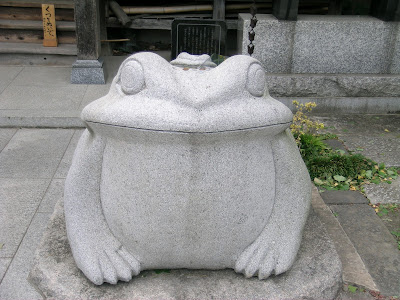Haiku Travels
Tokyo (Entenji in the Adachi ward)
skinny frog
don't give up the fight
Issa is here!
yasegaeru / makeru na Issa / koko ni ari
痩蛙まけるな一茶是に有り
Issa
[The haiku carved on a stone, standing together with frog figures in the garden of Entenji]
Issa (1763-1828) was born in Kashiwabara, in the snow country in the
north of present-day Nagano and was a devout follower of Jodo Shinshu
Buddhism. He led a life full of misfortunes and poverty, but his haiku
often describe the simple joys he also found. Issa is famous for his
empathy with small animals, even flies. He seems to have regarded them
as his equals, in the true Buddhist sense. In sort, Issa is one of the
most sympathetic of all haiku poets, someone you can easily relate to.
He was utterly without pretense, simple and straightforward - and so are
the more than 20,000 haiku he wrote.
When Issa visited Edo. he frequently lodged in a temple just outside the city, in present-day Adachi ward: Entenji. Issa wrote the following haiku about this temple:
When Issa visited Edo. he frequently lodged in a temple just outside the city, in present-day Adachi ward: Entenji. Issa wrote the following haiku about this temple:
crickets are chirpingThis haiku is a greeting to the temple, pairing this "blazing temple" with the semi, the cicadas who in summer make a deafening noise.
in Sixth-Month-Village's
Temple of the Blazing Sky
semi naku ya | Rokugatsumura no | Entenji
蝉鳴や六月村の炎天寺
[Entenji Temple]
Entenji was founded in the 11th century and strangely enough, the origin
of this small and peaceful temple lies in war. Minamoto no Yoriyoshi
and Yoshiie, father and son, were on their way to Northern Japan to
fight the Abe Clan, which had risen in revolt. When they passed through
this area, they were attacked by fierce Kanto samurai. After imploring
the help of Hachiman, the war god and patron deity of the Minamoto, they
won the difficult battle. Out of gratitude they founded a temple and a
Hachiman Shrine - the shrine still sits next to the temple. The name
they selected for the temple was enten or "Blazing Sky," as the
battle took place in the sixth month, in the worst heat of summer.
Afterwards, the area took on the name Rokugatsumura, "Village of the
Sixth Month," after the month in which the battle had been waged - and
Rokugatsu is still the name of the neighborhood.
The main image of the temple is an Amida Nyorai - after all, Hachiman
was considered as this Buddha's avatar. There are also a Yakushi and a
Fudo Myo-o. In the grounds stand various old and new monuments, such as a
beautiful set of the Six Jizo and a stone pagoda. The temple is small,
but tasteful and only a short walk from Takenotsuka station in the
Adachi ward, the most northern part of Tokyo.
The temple now is famous among haiku fans for Issa. There are a few haiku stones, and an impressive modern statue of Issa. Thanks to Issa, Entenji has become a haiku temple, holding an Issa- festival every year on November 23, when haiku are collected from primary and middle school students all over Japan.
The frog featuring in the haiku at the top of this page was a particular favorite of Issa. This poem, written in 1816, describes a sort of "frog sumo," but not for sport: the frogs are fighting over a female. As usual, Issa hopes the weak, skinny frog will win, a sentiment I fully agree with, as I also dislike "favorites" and "stars." It is also possible that Issa sees his own image in the skinny frog. Some commentators go so far to claim that Issa, who married late, is also encouraging himself to find a wife, but that interpretation does not seem probable, as Issa had married two years before he wrote this haiku.
Next to the statue of Issa in Entenji is a small pond, in which a few stone frogs have been placed, and in front of the Main hall sits a huge frog called Fuku Kaeru, Lucky Frog (or "Luck Returning"), which is very popular with worshipers (but this one is not skinny at all!). The same is true of this haiku: the "sumo" of the skinny frog, encouraged by Issa, is one of the most popular haiku Issa ever wrote.
Both haiku have been carved on so-called "haiku stones" (kuhi) which stand next to the Issa statue in the grounds of Entenji. Entenji is 15 min on foot from the East exit of Takenotsuka St on the Tobu Isezaki line. Walk along the railway line, passing a long stretch of flats, until you reach a small park. Turn left after the park, and turn left again after the second block.
Haiku of Kobayashi Issa: http://haikuguy.com/issa/
Dew on the Grass: The Life and Poetry of Kobayashi Issa (2004, Brill's Japanese Studies Library)
[The photos in this post are my own]



